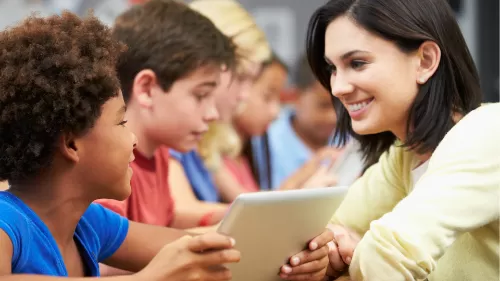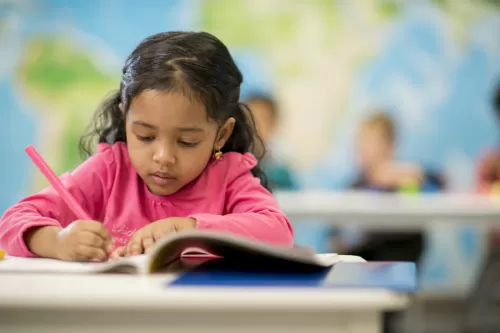Related searches

Building Blocks: What Digital Literacy Means for Kids
Digital literacy goes far beyond knowing how to type or use a tablet. For elementary students, it means understanding how to interact with technology meaningfully, ethically, and effectively. This includes learning how to search for reliable information, understand online privacy, use digital tools for collaboration, and begin coding or creating content. At the elementary level, the focus should be on helping students ask good questions, recognize safe and unsafe behaviors online, and begin developing a lifelong relationship with technology that’s both curious and cautious.
Safe Searching: Teaching Online Research and Fact-Checking
One of the first digital skills students should learn is how to find accurate information online. Digital literacy lessons can introduce simple tools like child-safe search engines (such as Kiddle or KidRex) and demonstrate how to compare sources. For example, students might explore a basic question—“What do pandas eat?”—and compare answers from multiple sites to see what information matches. Teaching them to spot red flags like sensational headlines, too many ads, or poorly designed websites builds early media literacy and encourages healthy skepticism.
Online Behavior and Digital Citizenship
Digital citizenship is one of the most crucial components of digital literacy, especially for younger users. Students should understand that the internet is a public space and that their words and actions leave a digital footprint. Lessons around kindness, respect, and empathy online can be integrated into classroom discussions. Interactive activities, such as “Would You Say That Face-to-Face?” or role-playing how to respond to a mean message, help kids connect the dots between online behavior and real-world consequences. Schools can also introduce frameworks like the “Think Before You Post” rule to guide responsible online interaction.
Introduction to Creative and Collaborative Tools
Digital literacy isn’t just about consumption—it’s about creation and collaboration, too. Elementary students can learn to use age-appropriate tools like Google Docs for group writing projects or Seesaw for digital journaling. These platforms foster communication and teamwork while building essential tech skills. Encouraging students to make a digital poster, record a short video, or code a simple game introduces them to the creative side of tech. These lessons empower students to express themselves and understand that they can shape the digital world—not just consume it.
Privacy, Passwords, and Personal Information
One of the most tangible lessons for elementary students is understanding what is—and isn’t—safe to share online. Even young students should know that information like full names, addresses, phone numbers, or school details should be kept private. Use fun activities like “Internet Detectives” to help students identify what’s personal information and brainstorm better usernames or passwords. Through games, songs, or interactive stories, students can learn the basics of protecting their online identity in a way that feels fun rather than fear-based.
Gamifying Digital Learning
Many digital literacy lessons are more effective when they feel like play. Tools like Common Sense Education, BrainPOP, and Code.org offer gamified learning platforms that introduce key digital skills in engaging, age-appropriate ways. Students can earn badges for identifying safe behaviors, completing coding challenges, or creating digital art. These platforms allow educators to blend skill-building with creativity while reinforcing lessons in a format that resonates with elementary-age learners. It also gives teachers real-time feedback on which concepts students are grasping—and which need more attention.
Laying the Foundation for a Digital Future
Digital literacy lessons for elementary students are more than just tech training—they’re life lessons for the digital age. By building these skills early, schools empower children to become critical thinkers, responsible digital citizens, and confident communicators. As technology continues to evolve, the students who are taught how to question, create, and collaborate from the start will be best positioned to lead tomorrow’s digital world. With the right mix of guidance, curiosity, and practice, today’s kids can grow into tomorrow’s digital leaders—one keystroke at a time.
 Early Educators Face Growing Strain as Preschool Expansion Stalls
Early Educators Face Growing Strain as Preschool Expansion Stalls Understanding Dyslexia in Special Education: A Guide for Parents and Educators
Understanding Dyslexia in Special Education: A Guide for Parents and Educators Supporting English Learners in Today’s Classrooms: A Path to Equity and Opportunity
Supporting English Learners in Today’s Classrooms: A Path to Equity and Opportunity How Can Teachers Use It in Instruction? Practical Strategies for the Modern Classroom
How Can Teachers Use It in Instruction? Practical Strategies for the Modern Classroom History Class Can Foster Literacy Skills: A Hidden Power in the Curriculum
History Class Can Foster Literacy Skills: A Hidden Power in the Curriculum


